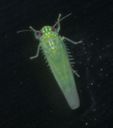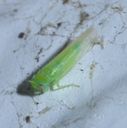Empoasca
Empoasca
Classification
- Phylum: Arthropoda
- Subphylum: Hexapoda
- Class: Insecta
- Order: Hemiptera
- Suborder: Auchenorrhyncha
- Infraorder: Cicadomorpha
- Superfamily: Membracoidea
- Family: Cicadellidae
- Subfamily: Typhlocybinae
- Tribe: Empoascini
- Subtribe: Empoascina
- Genus: Empoasca
Pronunciation
How to pronounce Empoasca: //ɛmˈpoʊ.æs.kə//
These audio files are automatically generated. While they are not always 100% accurate, they are a good starting point.
Images






Summary
Empoasca is a diverse genus of leafhoppers consisting of around 39 species worldwide, with 8 species noted in specific regions. Known for their role as sap feeders on a variety of plants, their potential agricultural impact makes them significant in both natural ecosystems and agriculture.
Physical Characteristics
Empoasca species are typically small to medium-sized leafhoppers, characterized by their elongated bodies and distinctive wing shapes. Their coloration can vary widely, often exhibiting greens, browns, or yellows that provide camouflage against the plants they inhabit.
Identification Tips
Look for their characteristic leafhopper shape, as well as the variations in color and size among the different species. Observing their behavior, particularly their jumping ability and feeding habits on leaves, can also aid in identification.
Habitat
Empoasca species are primarily found in agricultural and natural environments where host plants are present, such as fields, pastures, and gardens.
Distribution
While there are 8 species commonly encountered in our area, Empoasca is represented by a total of 39 species globally, indicating a widespread distribution across various continents.
Diet
Empoasca species primarily feed on plant sap, extracting nutrients from the phloem of their host plants with their specialized mouthparts.
Life Cycle
Empoasca undergoes an incomplete metamorphosis, involving egg, nymph, and adult stages. Nymphs resemble small adults and grow through several instars before reaching maturity.
Reproduction
Females lay their eggs on or near host plants, and the nymphs will begin feeding immediately after hatching, going through several stages before becoming adults.
Predators
Natural predators include various species of birds, predatory insects, and spiders, which help regulate their populations.
Ecosystem Role
As herbivores, Empoasca species play a role in plant dynamics and can affect crop health, while also serving as prey for various predator species, contributing to the food web.
Economic Impact
Empoasca can be agricultural pests, particularly in crops like fruits and vegetables, as they may transmit plant pathogens, leading to significant economic losses in agriculture.
Collecting Methods
- Sweep netting
- Pitfall traps
- Visual observation and hand collecting
Preservation Methods
- Ethanol preservation
- Pinning
- Slide mounting
Similar Taxa
- Typhlocyba
- Oncometopia
- Cicadella
Misconceptions
Some may confuse Empoasca with similar-looking leafhoppers that do not belong to this genus, leading to misidentification of species.
Tags
- leafhoppers
- Cicadellidae
- Empoasca
- hemiptera
- agricultural pests